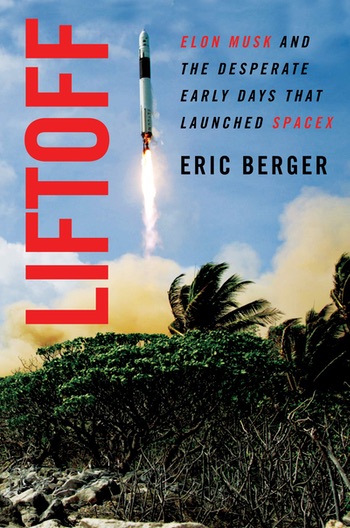Review: Liftoffby Jeff Foust
|
| “It hardened the DNA of the company,” recalled Bjelde. “It’s still there in the decisions we make today.” |
Liftoff, by veteran space journalist Eric Berger, provides the most detailed history yet of the early years of SpaceX, when many doubted a startup founded by a Silicon Valley millionaire could break into the launch business. The outlines of that history are familiar to those who have followed the industry (and read the pages of this publication): Elon Musk founds SpaceX after filing to buy a Russian rocket for a proposed Mars greenhouse; that startup develops a low-cost, small rocket, the Falcon 1, only to see it fail on its first three launches for three very different reasons; the company, running out of money, finally makes it to space on the fourth try.
Liftoff fills in those outlines in rich detail. Berger interviewed not just Musk and other top executives, like Gwynne Shotwell and Hans Koenigsmann, but also many of the early employees involved with the development of the Falcon 1 and launch operations at Omelek. In the early days of the company, the team was small and close-knit, with Friday afternoon ice cream runs and late-night gaming parties playing the first-person shooter game Quake that included Musk. Employees found it “cathartic to frag the boss,” Berger writes of those gaming sessions, because he “so often demanded the impossible.”
The impossible, those employees found, wasn’t actually impossible, just very, very difficult. Musk provided the vision and the initial funding, but it was up to the engineers to figure out ways to turn those raw materials into engines, structures, and electronics. The book is filled with stories from those people, tales of setbacks and successes along with other anecdotes of life at a company trying to do spaceflight in a very different way than traditional aerospace companies.
One of the biggest aspects of the early years of SpaceX, beyond development of the Falcon 1 itself, was launching from Kwajalein. That was not the company’s original plan: SpaceX intended to perform its first launches from Vandenberg Air Force Base, just a few hours’ drive up Highway 101 from its headquarters. But, while SpaceX worked out an agreement with the Air Force to take over an unused launch pad, the restrictions imposed on the company out of concerns that untried vehicle could interfere with national security missions led to Kwajalein, where the Army operated a missile defense installation.
Operating from Kwajalein imposed a new set of challenges on SpaceX, once they convinced the military to let them launch from there. (“I thought he was nuts,” recalled the Army colonel running the site, who hung up on Musk the first time he called about using Kwajalein.) The limited facilities there and the long supply chain back to California required an additional degree of ingenuity and inventiveness to create facilities to support the Falcon 1, and then carry out the launches. It also created an esprit de corps among those working there, with a little fun amid the long hours. Those who stayed overnight on Omelek, rather than commute by boat back to Kwajalein Atoll, were rewarded with a t-shirt based on the “Survivor” reality TV series logo.
| “I thought he was nuts,” recalled the Army colonel running the site, who hung up on Musk the first time he called about using Kwajalein. |
That experience made SpaceX stronger, but also nearly killed it when the first three Falcon 1 launches failed, putting the company at the risk of going out of business. It also shaped it in ways that last to this day, as Bjelde described. One example is that, before every launch, the company goes through the top eleven risks, rather than the top ten. The choice of eleven is not an homage to Spinal Tap, but instead a lesson from the second Falcon 1 launch. That launch failed when liquid oxygen started sloshing in the rocket’s upper stage, creating an oscillation. That potential was discussed in preparations for the launch, but ultimately considered only the eleventh highest risk for the avionics system. “Now,” Musk said, “I ask for the eleven top risks. Always go to eleven.”
Liftoff is rich with anecdotes from the early days of SpaceX that, put together, provide insights into the company that will be new for almost anyone who didn’t work at the company. The success that SpaceX enjoys today was by no means a sure thing, and as the book shows, the company came very close to failure in 2008 after the third Falcon 1 failure and with its funding nearly depleted. Hard work, and a little luck, allowed the fourth Falcon 1 to reach orbit and the company to find sound financial footing, including a NASA commercial cargo contract. The last decade-plus of spaceflight would be very different if SpaceX hadn’t persevered and survived those critical weeks in 2008.
The early employees profiled in Liftoff have contributed to the rise of commercial spaceflight beyond their work at SpaceX. They have created a diaspora of sorts, leaving SpaceX to work at companies like Firefly, Relativity, and Virgin Orbit. One of them, Chris Thompson, is now at Astra, where he leads launch system development. At SpaceX, he created the Survivor-themed t-shirts for those who overnighted at Omelek. Maybe he has a stash left over for the people who will be working there next year for Astra’s launches.
Note: we are using a new commenting system, which may require you to create a new account.
